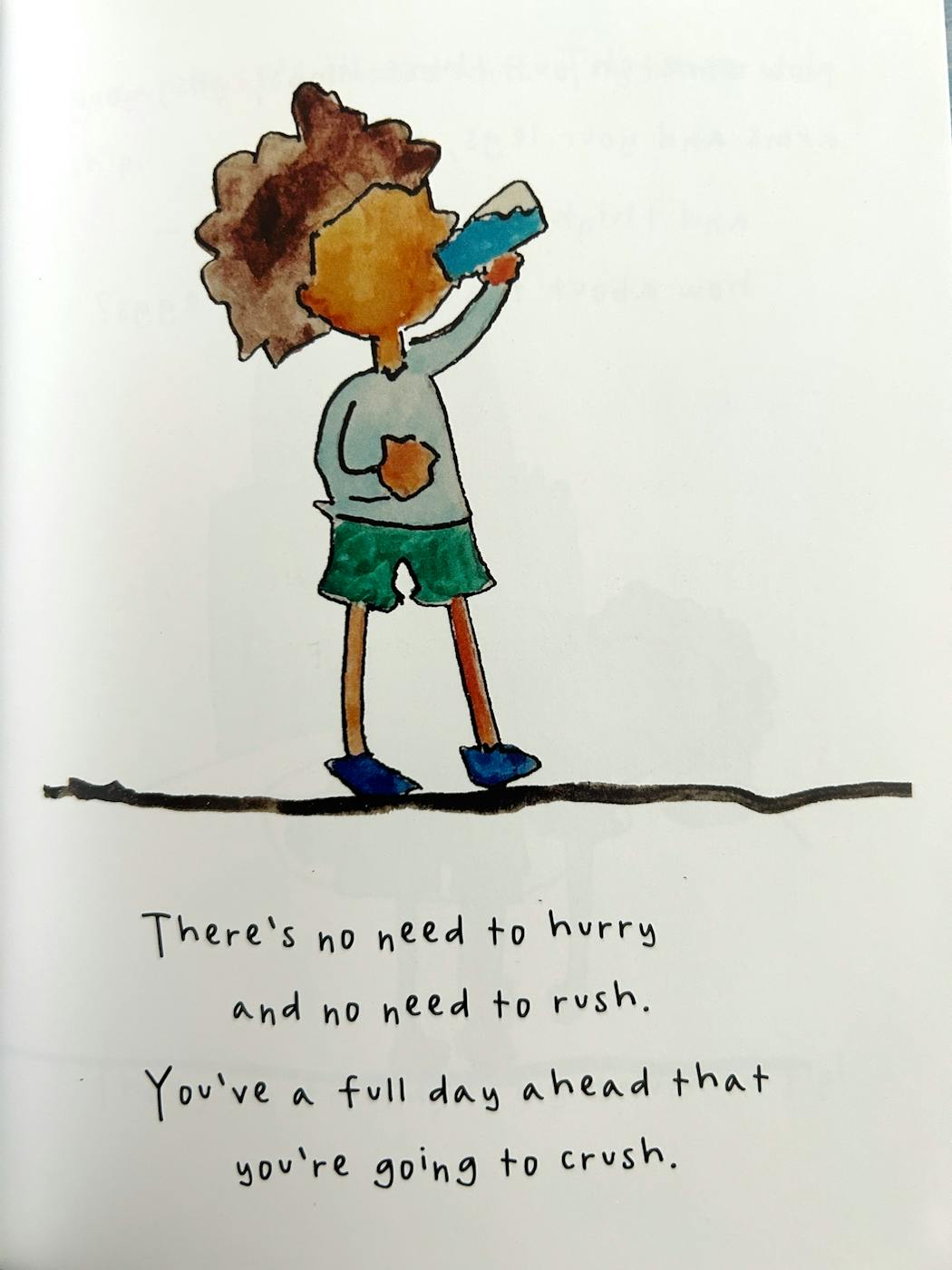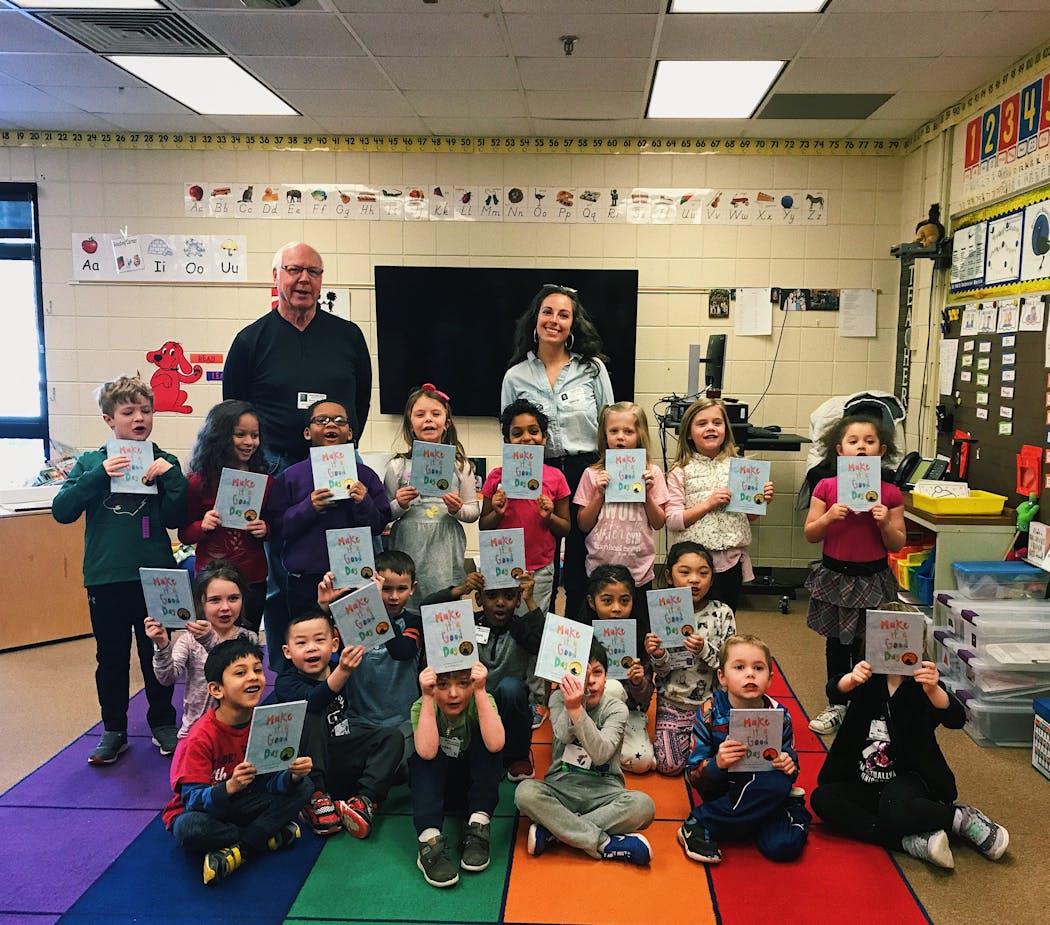It's clear from its title that "Make it a Good Day" takes a different approach from the familiar, perfunctory salutation "Have a good day." Right on the cover, the book tells readers they need not wait for a good day to happen to them — they can proactively make their day good themselves.
"A good day is all in your head, you decide when you roll out of bed," begins the 2018 children's book by Jennifer Universe, the pen name of Minneapolis author Jennifer Trebisovsky.
The book's tips for making a day go well, presented in four-line rhyming verses, are simple, even somewhat intuitive.
"The first thing to do is put a smile on your face, drink a big glass of water but at your own pace," the book advises, and continues with suggestions to stretch your limbs, eat a healthy breakfast, go outside and spend time in nature. Most adults already know that such habits are beneficial. Which doesn't mean those adults always practice them.
"Take a deep breath "down to your knees and your toes," Trebisovsky writes. "A deep breath will be useful throughout your whole day, it can help you reset when things don't go your way."
Trebisovsky wrote the book while living in a small oceanside cottage in San Diego, down the street from a Dr. Seuss museum, "the perfect place to write a children's book," she said.
After moving back to Minnesota, Trebisovsky published the book with St. Paul-based Beaver's Pond Press, a hybrid self-publishing company that offers editing, layout and distribution services.
This year she followed up with a sequel, "Make it a Good Night," told in similarly bouncy verse. It urges readers to look back on their day, recalling moments filled with pride, glee or laughter.
"Perhaps there was something that didn't go your way," the book adds. "Let it flow softly by with the rest of the day."
Both books are illustrated with simple but lively watercolors, painted by Trebisovsky. She doesn't consider herself a great artist, and even that holds a subtle message — you can paint your own illustrations even if you're not a professional.
She attributes her confidence to her days attending Annunciation Catholic School in Minneapolis, where artistic endeavors were encouraged. She took up painting again in 2014 to deal with grief after her grandmother ("my absolute best friend") died.
Trebisovsky's past jobs include restaurant manager, paralegal, co-creator of a travel website, purveyor of her own simple syrup. She has worked in public relations agencies and in 2020 became a freelance public relations and communications consultant.
At 34, she said, "I still don't know what I want to be when I grow up."
A fortuitous partnership
Trebisovsky often reads the book in classrooms to students ranging from kindergartners to sixth-graders.
"Younger kids are so pumped," she said. "With the older kids I think they do get it and a lot of them will kind of open up about, 'Oh, I had a tough day' or 'How do I deal with this bully?' It's kind of an everybody book."
One classroom visit a few years ago led to a serendipitous meeting and fortuitous partnership. Reading to a kindergarten class at Rice Lake Elementary School in Maple Grove, Trebisovsky met another volunteer, Dennis Warvin of Minnetonka.
Warvin runs a program called Maureen's Readers that he and his adult kids founded in 2019 in memory of his late wife, a retired third-grade teacher and avid reader.
Maureen's Readers distributes books — Warvin estimates they've passed the 5,000 mark — to children around the metro area, especially those who might not have many opportunities to acquire books.
He likes to find interesting — even sly — ways to get books into the hands of kids, including adding books to donated food bags, slipping books into lockers while kids are in class, giving books to young fathers at the Minnesota Correctional Facility in Red Wing so they can read to their visiting children.
Trebisovsky followed her reading, as she often does, with a watercolor exercise in which kids imagined and painted their own good day.
"Then she gathered all of those paintings, took them away, processed them somehow and actually put a book together," Warvin said. "They, as kids, became part of making a book!"
He learned that Trebisovsky shares the Maureen's Readers goal of picking schools where kids might not have many books at home.
Since then, he has donated funds for Trebisovsky to distribute about 300 books among classrooms across the Twin Cities, plus a school in Peru. That revenue helped pay for publication of "Make it a Good Night."
"I was just totally impressed by how she was so dedicated and that's her dream," Warvin said.
Easing kids' anxieties
Sometimes after a reading, students ask why the people in Trebisovsky's illustrations don't have faces. (The photos are simple and the faces are a wide range of colors, so the lack of facial features is noticeable but not glaring.) She encourages the kids to see themselves in the drawings.
But she also tells them she's not good at drawing faces. Sometimes they try to teach her to draw a face, "which is very enjoyable," she said.
That lets kids think, "'OK, I don't have to be the best artist,'" said Lindsey Jenson, a teacher at Expo for Excellence Elementary in St. Paul, where her class received books via Maureen's Readers. "They can decorate their own page with their own saying. I feel like it just eases their anxiety about drawing."
Ellis Richardson, a culture and climate specialist for North St. Paul-based School District 622, said that when he taught fourth grade, he read "Make it a Good Day" so often that his students can finish a verse just from hearing the first word.
"It really kind of set the tone of how we were going to approach the day — be mindful, be in the moment," said Richardson, a longtime friend of Trebisovsky's. "We used it as a tool for just, like, redirection. If we got off track with anything throughout the day, I could say, 'Which tool are you going to use — are you going to take a breath, hum a song?'"
Melissa Haggar-Olson, a former Park Terrace Elementary teacher, said her class tried different suggestions from the book every week.
"If a child was having a hard day, I would suggest he or she read the book in the calming corner to help get them back on track," she said.
Parents and teachers tell Trebisovsky that the book's advice helps them relax, too. Trebisovsky even reminds herself, when under stress, to take a deep breath all the way to her toes. Her mother taught her that trick when she was a kid.
On one bad day recently, she called her mom. "I said 'Ugh, things aren't going my way,' and she goes, 'Well, there's this book ...'"

The 5 best things our food writers ate this week

A Minnesota field guide to snow shovels: Which one's best?

Summer Camp Guide: Find your best ones here

Lowertown St. Paul losing another restaurant as Dark Horse announces closing





